.
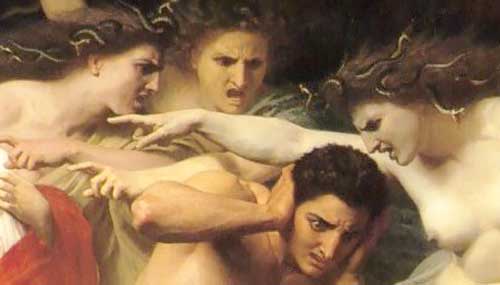
The Remorse of Orestes, part of a painting of William-Adolphe Bouguereau (the right Erinya probably a Venus de Milo version)
In Greek mythology the Erinyes or Eumenides (the Romans called them the Furies) were female personifications of vengeance. They were usually said to have been born from the blood of Uranus that fell upon Gaia when Cronus castrated him; i.e., they were chthonic (earth) deities. According to a variant account, they were born from Nyx. Their number is usually left indeterminate, though Virgil, probably working from an Alexandrian source, recognized three; Alecto ("unceasing"), Megaera ("grudging"), and Tisiphone ("avenging murder"). The heads of the Erinyes were wreathed with serpents, their eyes dripped with blood, and their whole appearance was terrific and appalling. Sometimes they had the wings of a bat or bird, or the body of a dog.
One myth had Tisiphone fall in love with Cithaeron. She caused his death by snakebite, specifically, one of the snakes from her head. Another myth says that the Erinyes struck the magical horse Xanthus dumb for rebuking Achilles.
”Hard by (Areopagos, Athens) is a sanctuary of the goddesses which the Athenians call Semnai, but Hesiod in the Theogony calls them Erinyes. It was Aeschylos who first represented them with snakes in their hair. But on the images neither of these nor or any of the underworld deities is there anything terrible.” Pausanias
The Erinyes generally stood for the rightness of things within the standard order; for example, Heraclitus declared that if Helios decided to change the course of the Sun through the sky, they would prevent him from doing so. But for the most part they were understood as the persecutors of mortal men and women who broke "natural" laws. In particular, those who broke ties of kinship through patricide, murdering a brother (parricide), or other such familial killings brought special attention from the Erinyes. It was believed in early epochs that human beings might not have the right to punish such crimes, instead leaving the matter to the dead man's Erinyes to exact retribution. The goddess Nike filled a similar role. When not stalking victims on Earth the Furies were thought to dwell in Tartarus where they applied their tortures to the damned souls there.
The Erinyes are particularly known for the persecution of Orestes for the murder of his mother, Clytemnestra. Since Apollo had told Orestes to kill the murderer of his father, Agamemnon, and that person turned out to be his mother, Orestes prayed to him. Athena intervened and the Erinyes turned into the Eumenides ("goodly ones"), as they always did in their beneficial aspects.
Many scholars believe that they were originally referred to as the Eumenides not to reference their good sides but as a euphemism to avoid their wrath by calling them by their true name. This is similar to the taboo on speaking the names of certain spirits in many cultures. The Erinyes were also known as Semnai ("the venerable ones"), the Potniae ("the Awful Ones"), the Maniae ("the Madnesses") and the Praxidikae ("the Vengeful Ones").
The Furies (their Roman name) or Dirae ("the terrible") typically had the effect of driving their victims insane, hence their Latin name furor.
Virgil VII, 324, 341, 415, 476.

Erinyes from the Pergamon Zeus Altar
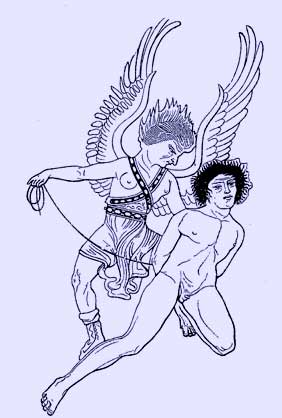
Detail of a vase painting , one of the Erinyes and Pirithous in the underworld. Red-figure volute krater with Hades and Persephone Watching a Fury Bind Theseus and Pirithous, South Italian, made in Apulia, 365–350 BC, terracotta. Attributed to the Suckling-Salting Group. Museo Archeologico Nazionale “G. Jatta,” Ruvo, 1094
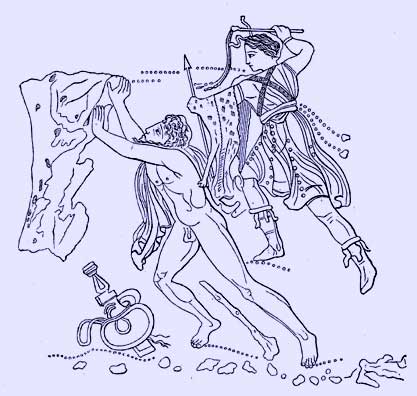
Detail of a vase painting from a vase now in Munich, one of the Erinyes and Sisyphus in the underworld
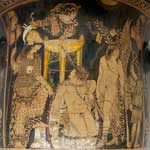
Orestes , Delphi BM GR1917.12-10.1
Athena, Apollo and one of the Erinyes
Erinyes in fiction
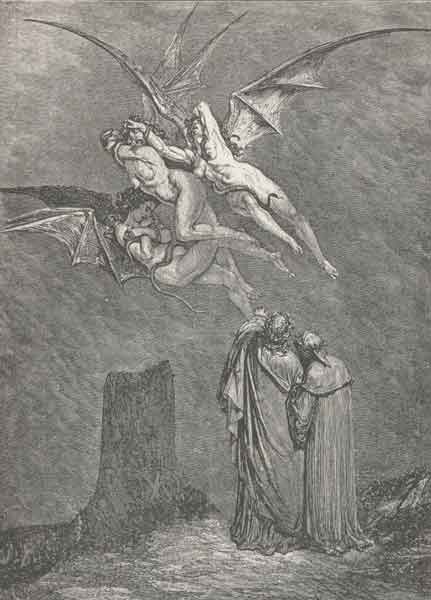
To the left
This is Megaera; on the right hand she,
Who wails, Alecto; and Tisiphone
I' th' midst. Dante's Inferno
In The Divine Comedy Dante sees the Erinyes at the gates of the city of Dis, which is the entry point to the four lower circles of Hell.
Leconte de Lisle's tragedy "Les Érinnyes" (1872), with accompanying music composed by Massenet.
Jean-Paul Sartre's 1943 play The Flies (Les Mouches) uses a retelling of the Oresteia (with the titular Flies being the Furies) in a modern perspective against religion [1].
The Furies are invoked by Hippolyta Hall in the ninth collection of the DC comic book series The Sandman, The Kindly Ones (which is also named for a translation of a name used for the Furies, Eumenides), because she mistakenly believes that Dream had kidnapped and murdered her child. Officially, the Furies are able to target Dream because he had recently killed his son Orpheus, and the Furies may take revenge on anyone who has shed family blood.
In Wildstorm's The Authority "Human on the Inside", the Furies show up at the request of Dr Ledbedder to initiate the destruction of the Authority. They claim to punish all who believe themselves good (that is: have superpowers).
Erinyes have been adapted in the TV series Charmed. They were portrayed as dog-faced women from Hell. They were called Furies and attacked human sinners with deadly smoke.
In the science fiction novel Path of the Fury by David Weber, Tisiphone, having died when the worship of Greek gods ceased, reappears in the future.
In the eponymous track of his first album, Rob Dougan calls them Furious Angels and poetically imagines that his love for a woman is so strong that, should she leave him, "furious angels will bring you back to me".
In Stephen King's novel Rose Madder, Erinyes is an angry, blind bull that lives in a maze within a painting.
In Robert Weinberg's sorcery-meets-modern-society novel A Calculated Magic, the Erinyes (referred to only as The Kindly Ones, the Furies, and the Eumenides) are regularly hired by a KGB operative to assassinate his targets for him.
In Dungeons & Dragons, erinyes are a kind of baatezu fiend charged with the temptation of mortals into evil deeds and service to the Nine Hells of Baator.
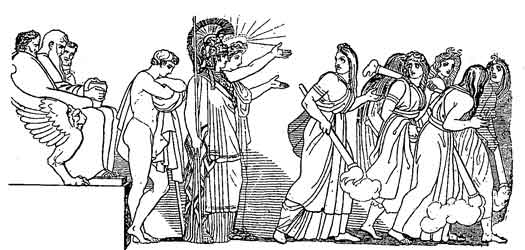
Athena , Apollo and the Erinyes, based on a drawing of Flaxman
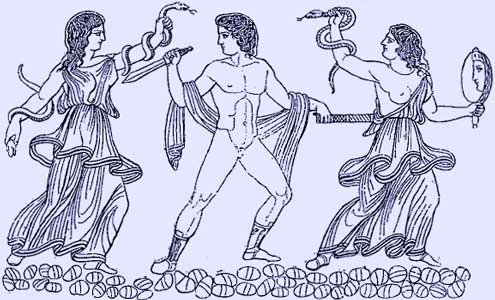
Orestes and the Erinyes
| Chthonic deities |
| Hades and Persephone, |
| Gaia, Demeter, Hecate, |
| Iacchus, Trophonius, |
| Triptolemus, Erinyes |
| Heroes and the Dead |
See also : Greek Mythology. Paintings, Drawings
| Ancient Greece
Science, Technology , Medicine , Warfare, , Biographies , Life , Cities/Places/Maps , Arts , Literature , Philosophy ,Olympics, Mythology , History , Images Medieval Greece / Byzantine Empire Science, Technology, Arts, , Warfare , Literature, Biographies, Icons, History Modern Greece Cities, Islands, Regions, Fauna/Flora ,Biographies , History , Warfare, Science/Technology, Literature, Music , Arts , Film/Actors , Sport , Fashion --- |
Retrieved from "http://en.wikipedia.org"
All text is available under the terms of the GNU Free Documentation License

